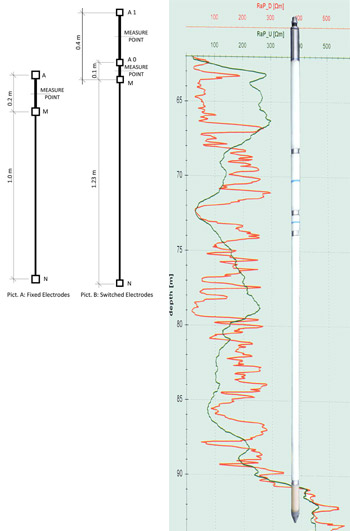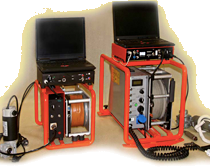Potential HR-380 P
The HR-380 P Potential probe measures specific resistance of surrounding rocks which, after the data evaluation, helps to determine the lithological boundary of permeable layers in a borehole or to follow structures of coal seams.
The Potential probe has the distance between unpaired electrodes smaller than the distance from the paired electrodes M - A0, A1.
Difference between the potential and gradient resistivity measurements are in shapes of resulting curves. The curve measured by a potential probe is symmetric in the point of maximal anomaly.
If the thickness of a layer is smaller than the length of the probe, the resulting curve shows minimal value.
Depth of investigation is given by the length of the probe: L = A to M.
A gradient probe (HR-380 Glu) is better at detecting of underlying or overlying boundaries of rocks. The shape of its resulting curve is non symmetrical. Length of the probe L = A to 0 gives N the depth of investigation.
The measured values of Rap and Rag are affected by the borehole diameter and by the specific resistivity of the mud cake.

Probe Parameters
| Available in diameters | 38 mm and 45 mm |
| Length | 2000 mm |
| Weight | 5,0 kg |
| Max. Working Pressure / Temperature | 10 MPa / 75 °C |
| Power Supply | 45 Vdc @ 120 mA |
Excitation frequency is 8 Hz; Operated on one conductor cable.
Output pulses of amplitudes/widths 8V / 6 µs (values are adjustable).
Measurement
The shorter channel (0,10 m) is active during winching the probe down. After reversing the direction of movement the other electrode (0,4 m channel) is activated.

